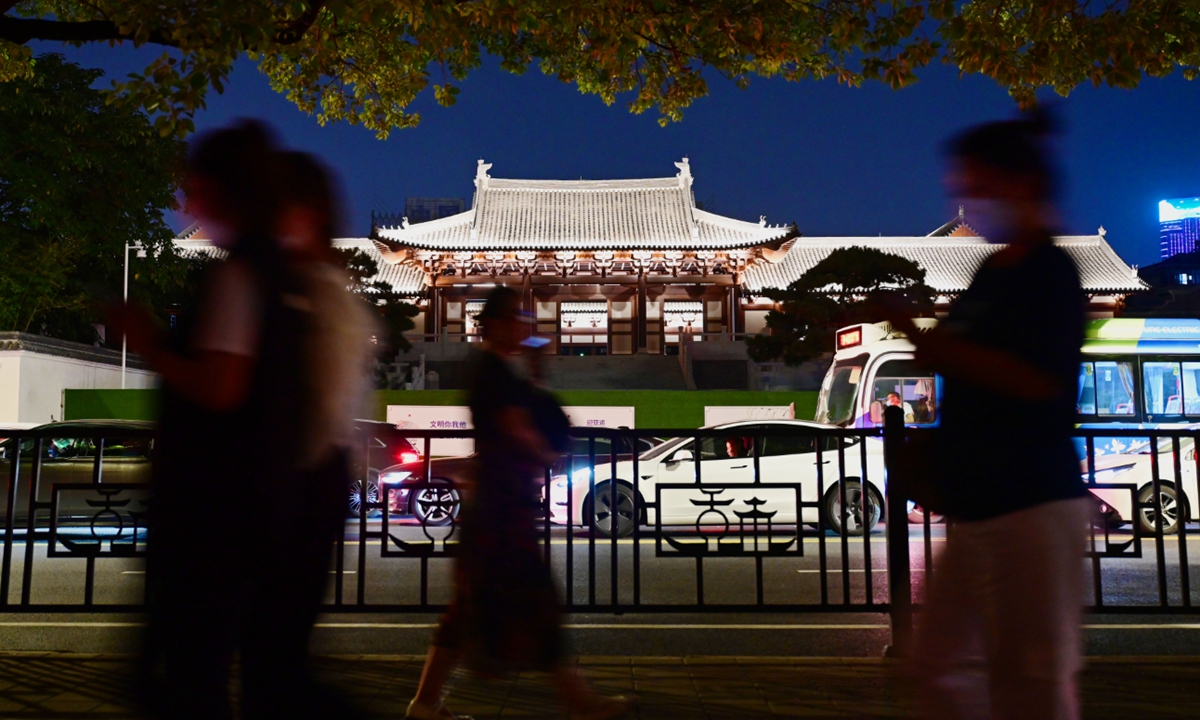
Deshou Palace Ruins Museum of the Southern Song Dynasty in Hangzhou, East China's Zhejiang Province Photo: VCG
Eleven new technology innovation centers that officially began operations recently in December 2024 will empower cultural and travel experiences through technology as part of efforts to advance the country's cultural and tourism sectors, an official from China's Ministry of Culture and Tourism (MCT) told the Global Times on Monday.
This first batch of established technology innovation centers covers several provinces and municipality: the provinces of Liaoning, Zhejiang, Fujian, Shandong, Hunan, Guangdong and Sichuan, as well as Beijing.
One notable application of technological innovation has been adopted in the Deshou Palace Ruins Museum of the Southern Song Dynasty in Hangzhou, East China's Zhejiang Province.
Thanks to digital technologies, the Deshou Palace Ruins have been restored. This "smart" presentation of the site is reflected in displays such as digital projections of historical scenes and also the digital reconstruction of the site after it was first built in the Southern Song Dynasty (1127-1279).
Transparent AR screens have been installed and placed beside relics. These screens directly simulate and display the original appearance of the Deshou Palace.
Xu Yitao, an architectural archaeologist who has witnessed the digital restoration of the site, told the Global Times that such a smart exhibition helps "large-scale architectural remains" become more vividly connected to the public instead of just being the research site of archaeologists.
Without such digital means, visitors are unlikely to get a clear picture of the site.
"For example, the remains at the Deshou Palace site mainly consist of building foundations, roads, drainage ditches, and water channels. Since the overall visual appeal of the actual site is relatively poor, it can be difficult for visitors to fully comprehend it," noted Li Yuanchu, a staff member of the museum.
"The original remains of the Deshou Palace cover a huge area. It is a great treasure that can be introduced to the public through technological means," Xu emphasized. He also added that archaeological architecture may not be as eye-catching as modern architecture, but over the years, smart designs and digital means have helped the public see the hidden treasures of ancient ruins.
Sun Yanan, a publicity manager at one innovation center in Northeast China's Liaoning Province, told the Global Times on Monday that the center is committed to researching the application and innovation of large-scale bionic performance machinery in the cultural and tourism sectors.
"By using large-scale bio-mechanical devices as a form of artistic expression, we aim to showcase the rich creativity found in Chinese myths and legends. We hope to create a 'Chinese Divine Beasts' series featuring legendary creatures from classic works such as Classic of Mountains and Seas and Journey to the West, bringing these legendary figures to life in a tangible and representational way," Sun noted.
At the Weifang World Kite Museum in East China's Shandong Province, by leveraging five major digital application scenarios - VR immersive cinemas, VR experience parks, digital interactive spaces, cultural creative workshops, and aerospace exhibition halls - the focus is on integrating advanced virtual reality and metaverse digital technologies with Weifang kite culture and intangible cultural heritage, providing visitors with a multi-sensory experience and diverse interactive experiences.
Other notable achievements include one center's collaboration with over 6,300 scenic spots, which has led to annual sales exceeding 300 million tickets sold. Another center's partner organizations are responsible for producing more than 80 percent of the world's mid-to-high-end virtual reality headsets, the Xinhua News Agency reported.
Du Gongwei, an official from the ministry's science and education department, told the Global Times in an interview on Monday that these centers focus on integrating technological innovation, talent cultivation, and resource integration to solve key technological challenges in the cultural and tourism fields and providing various enterprises with services ranging from research and development to pilot testing and product development.
"The ministry's technology innovation centers are playing an increasingly vital role in advancing and shaping the technological development of the industry," said Liu Dongyan, deputy director of the ministry's science and education department, according to a Xinhua report.
Liu also revealed that the selection process for the second batch of technology innovation centers is now underway.
"These new centers will address gaps in the current innovation system and enhance both technological and regional deployment strategies," Liu noted in the Xinhua report.




